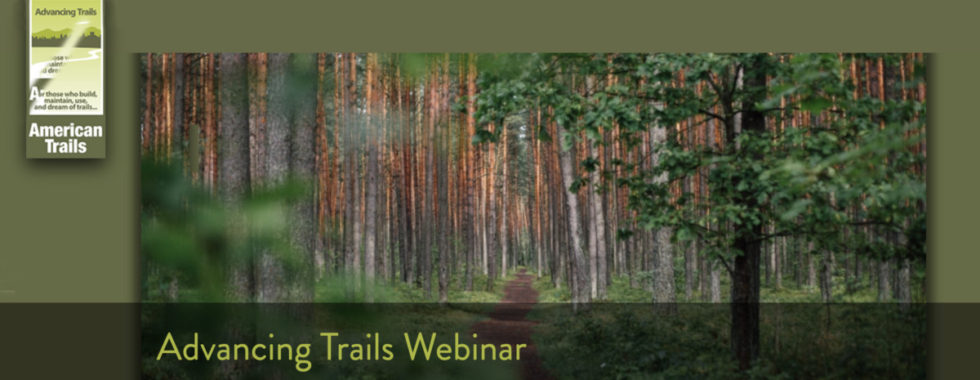The Added Value of Trails
Anyone who questions the value a trails system can bring to a community need only look at the story of Dayton, Ohio, which in 2008 was named by Forbes as one of America’s “Fastest Dying Cities.” How Dayton’s Five Rivers MetroParks helped it overcome that dubious distinction was the subject of a recent American Trails webinar attended by SMGA board member Susan Hanson.
As National Geographic reported in August 2019, “[I]n recent years, the city of around 800,000 has seen a surprising—and popular—revitalization of its urban green spaces, which welcomed some 3.3 million visitors in 2018. On a per-capita basis, this makes Dayton’s parks more popular than New York’s Central Park, the United States’ most-visited.” How could this be?
Speaking in the American Trails webinar “Creating Culture Change Through Outdoor Recreation,” Brent Anslinger, Outdoor Recreation Program Manager with Five Rivers MetroParks, said that the city’s process of transformation began, in part, with this question: “How are park users changing and how can we take advantage of that and engage them in new activities in their park system going forward?”
Even at its lowest ebb, the city of Dayton had an invaluable resource, its public lands. “We have 16,000 acres, 90% managed in its natural state,” Anslinger explained. “We don’t have swimming pools, ball fields, zoos. We have trail systems, river access, mountain biking, those sorts of human-powered natural nature-based activities. We have 270 miles of river corridor, 42 of those maintained in the park system.”
Thanks to major flooding in the early 20th century, Dayton is also crisscrossed by dams and levees, many of which connect large parcels of public lands. Under the leadership of Horace Huffman, president of Huffy bicycles, work was begun in the mid-sixties to use these levees as the basis for a bikeway system. This paved trail network has continued to develop right up to the present. Today it measures more than 350 miles and has the distinction of being the nation’s largest paved trail network.
Recognizing that people weren’t using the parks as they once did—for picnicking and socializing—the city of Dayton hired Greg Brumitt as a contractor in 2006. Brumitt had just completed a thesis on how outdoor recreation could be an economic driver for a Midwestern Rust Belt community and was eager to put some of his ideas into practice. Hired at the same time, Anslinger said this “intentional transition to something more active” was dependent on developing partnerships among like-minded groups, teaching skills, encouraging community involvement, and creating greater access to resources.
Key to Dayton’s success, Anslinger noted, was the recognition that it need not—indeed could not—offer what was already available in either Columbus or Cincinnati, each about an hour’s drive away. That could be looked at as a disadvantage, he admitted, or it could be seen as the impetus for showcasing the city’s unique amenities—specifically the bike trails, hiking trails, and paddling trails.
One of the benefits of having such an extensive and diverse park system is the ability to hold several community-wide events each year, added Angela York, Outdoor Recreation Special Events Coordinator for Five Rivers MetroParks. For example, in addition to featuring outdoor retailers and a variety of demonstrations, Dayton’s annual Adventure Summit includes skills competitions, hands-on instruction, and even the opportunity for such experiences as overnight camping. “We wanted to showcase local resources like our outdoor clubs and to have a safe place to introduce new audiences to outdoor recreation,” said York, adding that the event also models good environmental stewardship by diverting 80% of its waste from the landfill.
Like many other economically hard-hit Midwestern urban areas, Dayton still has much work to do in making the transition from an industrial to post-industrial city. And yet, thanks in large part to the success of its system of biking, hiking, and paddling trails, it has gone from being named one of America’s “fastest dying cities” in 2008 to “America’s newest adventure capital” in 2019.
What might Dayton’s story mean to San Marcos? The two cities differ in a great many respects—size, economic base, and public land holdings among them. But located as they are in the shadow of two larger cities, they do share one thing: the need to find and celebrate what makes them unique. And in both cases, the answer is outdoor recreation, including municipal projects like the trails created and maintained by the Greenbelt Alliance, and regional efforts like the proposed Emerald Crown Trail.
Written by Susan Hanson, a member of the SMGA board and chair of the Outreach Committee.


